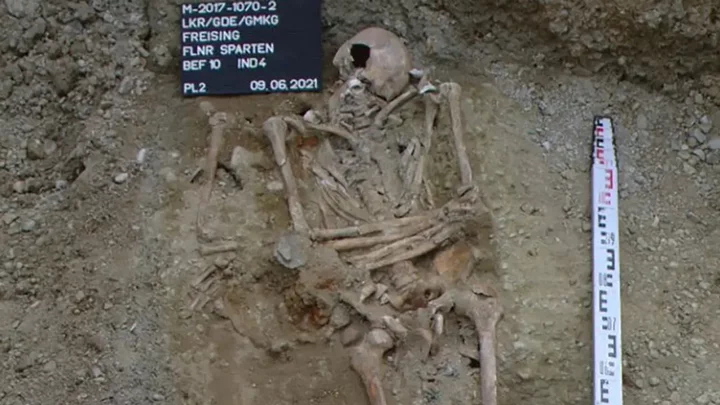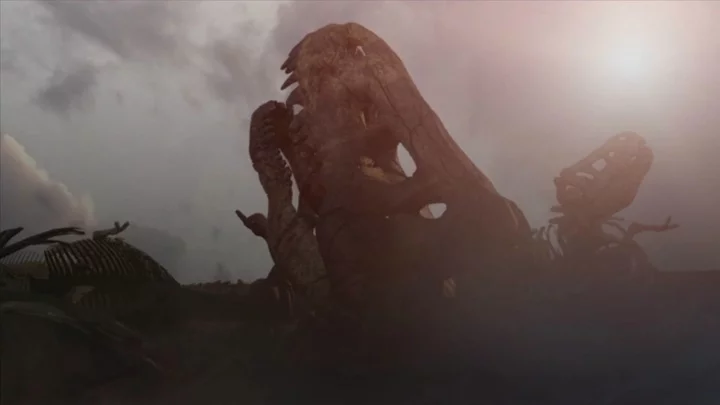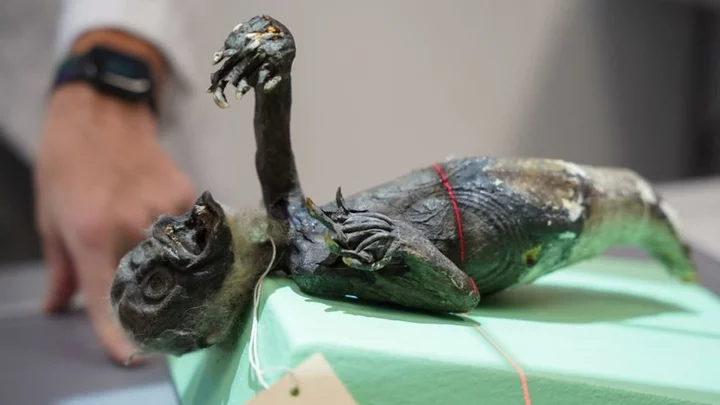
Apple’s Top iPhone Supplier Goes to Outer Space With New Satellites
The world’s biggest producer of iPhones is going to outer space. Two prototype low-Earth orbit satellites made by
2023-11-12 09:57

EU Makes Deal to Advance Controversial Nature-Restoring Law
The European Union clinched a deal to advance one of the most controversial aspects of its green agenda:
2023-11-10 16:19

China 2024 Budget Deficit Seen Above 3.5% In Break With Past
China will likely set its headline deficit at 3.5% of gross domestic product or higher next year, according
2023-11-10 15:58

Scientists discover new truth about the Sun's structure
Our understanding of the Sun may have completely changed after astronomers calculated that it might not be quite as big as we thought it was. The Sun is so powerful that it can disrupt the Earth’s magnetic field giving us the Northern Lights. It also continually baffles scientists, as one recent discovery found that part of the Sun is broken. Now, experts have discovered that the Sun may be a bit smaller than everyone thought, which could alter how we think of the star at the centre of our universe. Two astronomers made the calculation that the radius of the Sun is smaller, by a few hundredths of a per cent, than originally believed. The results, which are being peer-reviewed, are based on evidence gathered from sound waves that are made and trapped inside the burning hot sun. These sound waves are known as p-modes and they make noise like a growling stomach, suggesting a pressure change in the Sun’s interior. Analysing p-mode oscillations offers a “dynamically more robust” understanding of the Sun’s insides, according to astrophysicists Masao Takata from the University of Tokyo and Douglas Gough from Cambridge University. According to their research using evidence from p-modes, the solar photospheric radius is fractionally smaller than calculations made using the traditional reference model for the Sun’s seismic radius that analyses waves called f-modes. The reason for this difference is not very well understood. Astrophysicist Emily Brunsden told New Scientist: “To understand the reason for their difference is tricky because there’s just a lot of things going on.” How to join the indy100's free WhatsApp channel Sign up to our free indy100 weekly newsletter Have your say in our news democracy. Click the upvote icon at the top of the page to help raise this article through the indy100 rankings.
2023-11-09 19:48

Elon Musk wants a volunteer to have their head cut open for his brain implants
Elon Musk's chip implant company Neuralink is looking for its first volunteer since the company got approved to perform tests on humans by the FDA. Prior to its approval for human clinical trials, Reuters reported that the company had killed roughly 1,500 animals during testing. The volunteer would have to be willing to have a piece of their skull removed so a robotic surgeon can insert thin wires and electrodes into their brain. The company told Bloomberg News, the ideal candidate will be a quadriplegic under the age of 40. Neuralink hopes to eventually make a device that will allow people to send messages or play games using only their thoughts. Ashlee Vance, the author of the 2015 biography 'Elon Musk: Tesla, SpaceX, and the Quest for a Fantastic Future', said in his Bloomberg report that despite "an outpouring of interest from thousands of prospective patients," the company is still seeking its first volunteer. The chip would enable computer functions to be performed using only thoughts via a "think-and-click" mechanism. If the ideal volunteer is chosen, a surgeon will remove part of the person's skull, before a robot dubbed "R1", equipped with cameras, sensors and a needle will push 64 threads into the brain whilst doing its best to avoid blood vessels. Reassuring. Each thread has roughly the diameter of 1/14th of a strand of human hair, and is lined with 16 electrodes that are programmed to gather data about the brain. The electrodes record neural activity related to movement intention, which is then decoded by Neuralink computers. Neuralink did not reveal how many participants would be enrolled in the trial or how many patients the FDA ultimately approved, after a negotiation between the company and agency which raised safety concerns, according to current and former employees. DJ Seo, co-founder and vice president for engineering of Neuralink told Bloomberg: "The short-term goal of the company is to build a generalised brain interface and restore autonomy to those with debilitating neurological conditions and unmet medical needs." "Then, really, the long-term goal is to have this available for billions of people and unlock human potential and go beyond our biological capabilities." Indy100 has reached out to Neuralink for comment. Sign up to our free Indy100 weekly newsletter Have your say in our news democracy. Click the upvote icon at the top of the page to help raise this article through the indy100 rankings. How to join the indy100's free WhatsApp channel
2023-11-09 02:19

'Sophisticated' prosthetic hand found on medieval skeleton
If you thought prosthetic hands were too advanced for people living hundreds of years ago, think again. Archaeologists have found the remains of a man who died in Medieval Germany, who had prosthetics in place of several fingers. The grave was found by pipeline workers in Freising, a town near Munich. The Bavarian State Office for Monument Preservation said: “Even for experienced archaeologists, this was a particularly special find: a skeleton in which parts of the fingers of its left hand are missing.” The archaeologists removed the metal from the man’s skeleton to restore and analyse it. They came to the conclusion that he had lost his fingers at some point in his life. Walter Irlinger, deputy of the general conservator at BSOMP, said: “The hollow prosthetic on the left hand replaced four fingers. The index, middle, ring and pinky fingers are individually formed out of sheet metal and are immobile. The prosthetic fingers lie slightly curved, parallel to one another.” The prosthetic also had scraps of fabric and leather, suggesting that the fingers had a leather cover, and were tied to the hand using straps. There was also a gauze-like material inside the fingers, which may have acted as a cushion for the man’s skin from contact with the metal. That period of German history included the Thirty Years’ War, which ended in 1648, which would have increased the need for amputations and prosthetics. One of the most famous amputees from the time was Götz von Berlichingen – or “Götz of the Iron Hand”. He was a German knight who lost his right hand from a cannon injury at the siege of Landshut in 1504. “In the past, prosthetics looked very much like what they were replacing,” said Jacky Finch, a researcher in the KNH Center for Biomedical Egyptology at the University of Manchester. “Nowadays, implants are placed in the sensory system to control nerve action, rather than devices attached to the body by straps or artificially powered.” The BSOMP statement continued: “Doctors at that time were already thinking about how they could make life easier for amputees. “In central Europe, there are currently around 50 similar prostheses from the late middle ages to early modern age that are known.” How to join the indy100's free WhatsApp channel Sign up to our free indy100 weekly newsletter Have your say in our news democracy. Click the upvote icon at the top of the page to help raise this article through the indy100 rankings.
2023-11-08 01:49

Astronauts capture the 'blood of Earth' in stunning photo
The Earth is home to truly stunning natural features, but sometimes you need a new perspective to appreciate it all over again. Thankfully, the experts at NASA are on hand to remind us just how incredible our planet is with the release of new photos showing the “blood of Earth”. The incredible images seem to show it bleeding, with dramatic red liquid appearing to cascade over the surface. However, it’s nothing at all to do with blood – which is probably just as well. Instead, the first picture shows the Laguna Colorada in the Bolivian Andes in South America from space. Remarkably, the image was taken by an astronaut onboard the International Space Station (ISS) using just a Nikon digital camera. The fact that it was taken more than 400 kilometres away from Earth on a handheld device is pretty staggering, and it offers a look at a natural phenomenon which we’d never otherwise get to see. The first picture shows the impact of red algae flourishing in the shallow water of the laguna, while the second shows the Betsiboka River Delta in Madagascar. This time, the red colour comes as a result of the iron-rich sediment. It’s pretty awe-inspiring stuff, and it’s not the first time that red “blood” has been seen running from our planet, either. Antarctica’s Blood Falls is a bizarre geographical feature in the McMurdo Dry Valleys region of the continent, and it’s one of the strangest natural phenomena you're likely to see. It features a flow of water the colour of blood that can be seen seeping out from a glacier into the ocean. The mystery behind it has fascinated members of the scientific community for decades, but a solution has now been found. Sign up for our free Indy100 weekly newsletter How to join the indy100's free WhatsApp channel Have your say in our news democracy. Click the upvote icon at the top of the page to help raise this article through the indy100 rankings
2023-11-07 20:25

Scientists think they’ve finally solved the mystery of how the dinosaurs went extinct
It’s one of the questions which has fascinated scientists for hundreds of years, but how did the dinosaurs really go extinct? Well, new research might have just solved the mystery once and for all. Of course, most people are familiar with the fact that an asteroid struck the Earth around 66 million years ago, but fewer people might know that the object measured a whopping 10 to 15 kilometres wide and landed in Mexico’s Yucatan Peninsula. Fewer people still might know that while it sparked all sorts of devastation, including earthquakes and megatsunamis, and now experts have revealed that what might have really proved fatal for the dinosaurs was the dust that it caused. We’re not talking a little bit of dust, either. Trillions of tons of the stuff was released into the atmosphere when then asteroid struck. The damage done by this dust is explored in the new report published by Nature Geoscience. So much was released, in fact, that it caused a “global winter”, with huge clouds of silicate dust and sulphur causing temperatures to drop by 15C. The lack of light would have caused entire ecosystems to collapse, causing 75 per cent of species to be rendered extinct. The effects of the dust could have blocked out sunlight for as long as two years, which according to the Belgium researchers who led the study is what would have killed off dinosaurs gradually – rather than being killed off straight away by the asteroid. It is, however, what eventually led to other life forms emerging and ultimately the development of the human race. "Dinos dominated Earth and were doing just fine when the meteorite hit," co-author of the study and planetary scientist Philippe Claeys said. "Without the impact, my guess is that mammals - including us - had little chance to become the dominant organisms on this planet." Sign up for our free Indy100 weekly newsletter How to join the indy100's free WhatsApp channel Have your say in our news democracy. Click the upvote icon at the top of the page to help raise this article through the indy100 rankings
2023-11-07 19:24

Why Do Some Male Lions Lack Manes?
Climate can cause a big difference in how much hair a lion grows.
2023-11-02 02:52

Relics of huge primordial collision reside in Earth's deep interior
By Will Dunham WASHINGTON Seismologists have recognized since the 1970s that two mysterious continent-sized blobs reside in the
2023-11-02 00:25

Remembering Ada Lovelace, the First ‘Computer Programmer’
In the 1840s, Ada Lovelace wrote the world’s first machine algorithm for an early computer that existed only on paper.
2023-11-01 22:52

‘Mermaid mummy’ from Japan found to be a Frankenstein's mix of body parts
Frankenstein’s monsters aren’t just for Halloween, as a team of US scientists have recently discovered. The experts at Northern Kentucky University (NKU) were tasked with analysing the remains of a supposed mummified “mermaid”, and what they found was pretty gruesome. The mummy was brought to America from Japan more than 100 years ago after being donated it to the Clark County Historical Society in Springfield, Ohio. It arrived at the society in 1906 but documents supplied alongside the strange specimen suggest it dates back to the mid-1800s. This means that for some 170 years, the true identity of the wisened, 29-cm-long creature remained a mystery. However, thanks to modern technology, the team at NKU has finally worked out that the sinister-looking “siren” is, in fact, a ghoulish hybrid of monkey, fish and lizard. Joseph Cress, who led the project, told Live Science that he and his colleagues used X-ray and CT scans to investigate the creepy cadaver. "This allowed us to see [the mummy] in almost every dimension in the hopes to see what was inside it," he explained. They determined that that the “mermaid” consists of the head and torso of a monkey sewed onto the body of a fish, and its “hands” are the clawed legs of a lizard – most likely a Komodo dragon. The scans also revealed a pair of wooden stakes hidden inside the chimeric corpse – one running from head to tail and another across the shoulder blades — which were presumably inserted to keep the monster in one piece. Cress and his colleagues are currently trying to reconstruct a more detailed model of the mermaid and its individual components, according to Live Science. Once these models are complete, they plan to send them to zoos and aquariums to help confirm the different parts on a species level. However, jaw-dropping this specimen may be, it's not the only “mermaid” to be debunked in recent times. In March 2022, researchers analysed a similar example that was found in a hidden box in a Japanese temple. They also expected the creature, which was 30.5 cm long and dated back to the mid-1700s, to be a monkey-fish hybrid. However, tests conducted in February this year revealed that it was, in fact, predominantly made of cloth, paper and cotton. It had been painted with sand and charcoal and held together by metal pins, while various animal parts, including fish skin and mammal hair, had been stuck to it. Experts believe that the two “mermaids” were made to resemble "ningyo" — hideous fish-like creatures with human heads and sharp claws from Japanese mythology. According to legend, a nun named Yaobikuni lived for 800 years and retained the youthful appearance of a young woman, after eating a ningyo. Her immortality made the creatures a symbol of longevity, so it’s likely that fraudsters tried to recreate the mermaids to sell them to wealthy seekers of immortality. Still, at least the owners of these two examples didn’t make the mistake of trying to eat them. Sign up for our free Indy100 weekly newsletter Have your say in our news democracy. Click the upvote icon at the top of the page to help raise this article through the indy100 rankings
2023-11-01 19:18
